Causes of Increased Compound Temperature and Precipitation Extreme Events in the Arid Region of Northwest China from 1961 to 2100
Abstract
:1. Introduction
2. Materials and Methods
2.1. Study Area
2.2. Data
2.2.1. Measured Data
2.2.2. CMIP6 Data
2.3. Definition of Compound Extreme Temperature and Extreme Precipitation Events
3. Results
3.1. Observed Changes in CEEs
3.1.1. Annual Variations in Compound Events
3.1.2. Spatial Distribution of Compound Events
3.2. Projections of Compound Weather Extreme Events
3.2.1. Annual Variations in Compound Events
3.2.2. Spatial Distribution of Compound Events
4. Discussion
4.1. Influence Factor for the Warmer and Wetter Trend in the NWC
4.2. Driving Mechanism for HE-D Events
4.3. Driving Mechanism of HE-HP Events
4.4. Limitations and Outlooks
5. Conclusions
Supplementary Materials
Author Contributions
Funding
Data Availability Statement
Conflicts of Interest
References
- IPCC. AR6 Climate Change 2021: The Physical Science Basis. 2021. Available online: https://www.ipcc.ch (accessed on 8 May 2024).
- Martius, O.; Pfahl, S.; Chevalier, C. A Global Quantification of Compound Precipitation and Wind Extremes. Geophys. Res. Lett. 2016, 43, 7709–7717. [Google Scholar] [CrossRef]
- Yu, R.; Zhai, P. Changes in Compound Drought and Hot Extreme Events in Summer over Populated Eastern China. Weather Clim. Extrem. 2020, 30, 100295. [Google Scholar] [CrossRef]
- Zscheischler, J.; Westra, S.; Van Den Hurk, B.J.J.M.; Seneviratne, S.I.; Ward, P.J.; Pitman, A.; AghaKouchak, A.; Bresch, D.N.; Leonard, M.; Wahl, T.; et al. Future Climate Risk from Compound Events. Nat. Clim. Chang. 2018, 8, 469–477. [Google Scholar] [CrossRef]
- Zscheischler, J.; Martius, O.; Westra, S.; Bevacqua, E.; Raymond, C.; Horton, R.M.; Van Den Hurk, B.; AghaKouchak, A.; Jézéquel, A.; Mahecha, M.D.; et al. A Typology of Compound Weather and Climate Events. Nat. Rev. Earth Environ. 2020, 1, 333–347. [Google Scholar] [CrossRef]
- Yu, R.; Zhai, P. Advances in scientific understanding on compound extreme events. Trans. Atmos. Sci. 2021, 44, 645–649. [Google Scholar] [CrossRef]
- Peng, T.; Zhao, L.; Zhang, L.; Shen, X.; Ding, Y.; Wang, J.; Li, Q.; Liu, Y.; Hu, Y.; Ling, J.; et al. Changes in Temperature-Precipitation Compound Extreme Events in China during the Past 119 Years. Earth Space Sci. 2023, 10, e2022EA002777. [Google Scholar] [CrossRef]
- Stott, P. How Climate Change Affects Extreme Weather Events. Science 2016, 352, 1517–1518. [Google Scholar] [CrossRef] [PubMed]
- Alizadeh, M.R.; Adamowski, J.; Nikoo, M.R.; AghaKouchak, A.; Dennison, P.; Sadegh, M. A Century of Observations Reveals Increasing Likelihood of Continental-Scale Compound Dry-Hot Extremes. Sci. Adv. 2020, 6, eaaz4571. [Google Scholar] [CrossRef] [PubMed]
- Bevacqua, E.; Zappa, G.; Lehner, F.; Zscheischler, J. Precipitation Trends Determine Future Occurrences of Compound Hot–Dry Events. Nat. Clim. Chang. 2022, 12, 350–355. [Google Scholar] [CrossRef]
- Allan, R.P.; Willett, K.M.; John, V.O.; Trent, T. Global Changes in Water Vapor 1979–2020. JGR Atmos. 2022, 127, e2022JD036728. [Google Scholar] [CrossRef]
- Ren, D.; Wang, Y.; Wang, G.; Liu, L. Rising Trends of Global Precipitable Water Vapor and Its Correlation with Flood Frequency. Geod. Geodyn. 2023, 14, 355–367. [Google Scholar] [CrossRef]
- Zhang, J.; Zhao, T.; Dai, A.; Zhang, W. Detection and Attribution of Atmospheric Precipitable Water Changes since the 1970s over China. Sci. Rep. 2019, 9, 17609. [Google Scholar] [CrossRef]
- Hoell, A.; Quan, X.-W.; Hoerling, M.; Diaz, H.F.; Fu, R.; He, C.; Lisonbee, J.R.; Mankin, J.S.; Seager, R.; Sheffield, A.; et al. Water Year 2021 Compound Precipitation and Temperature Extremes in California and Nevada. Bull. Am. Meteorol. Soc. 2022, 103, E2905–E2911. [Google Scholar] [CrossRef]
- Yin, J.; Gentine, P.; Slater, L.; Gu, L.; Pokhrel, Y.; Hanasaki, N.; Guo, S.; Xiong, L.; Schlenker, W. Future Socio-Ecosystem Productivity Threatened by Compound Drought–Heatwave Events. Nat. Sustain. 2023, 6, 259–272. [Google Scholar] [CrossRef]
- Zhang, Y.; Mao, G.; Chen, C.; Lu, Z.; Luo, Z.; Zhou, W. Population Exposure to Concurrent Daytime and Nighttime Heatwaves in Huai River Basin, China. Sustain. Cities Soc. 2020, 61, 102309. [Google Scholar] [CrossRef]
- Xing, Z.; Yu, Z.; Wei, J.; Zhang, X.; Ma, M.; Yi, P.; Ju, Q.; Wang, J.; Laux, P.; Kunstmann, H. Lagged Influence of ENSO Regimes on Droughts over the Poyang Lake Basin, China. Atmos. Res. 2022, 275, 106218. [Google Scholar] [CrossRef]
- Wang, X.; Li, Y.; Chen, Y.; Li, Y.; Wang, C.; Kaldybayev, A.; Gou, R.; Luo, M.; Duan, W. Intensification of Heatwaves in Central Asia from 1981 to 2020—Role of Soil Moisture Reduction. J. Hydrol. 2023, 627, 130395. [Google Scholar] [CrossRef]
- Ma, Z.; Sun, P.; Zhang, Q.; Zou, Y.; Lv, Y.; Li, H.; Chen, D. The Characteristics and Evaluation of Future Droughts across China through the CMIP6 Multi-Model Ensemble. Remote Sens. 2022, 14, 1097. [Google Scholar] [CrossRef]
- Beniston, M. Trends in Joint Quantiles of Temperature and Precipitation in Europe since 1901 and Projected for 2100: Joint heat and moisture extremes. Geophys. Res. Lett. 2009, 36, L07707. [Google Scholar] [CrossRef]
- Hao, Z.; AghaKouchak, A.; Phillips, T.J. Changes in Concurrent Monthly Precipitation and Temperature Extremes. Environ. Res. Lett. 2013, 8, 034014. [Google Scholar] [CrossRef]
- Ma, Q.; Li, Z.; Chen, Z.; Su, T.; Wu, Y.; Feng, G. Moisture Changes with Increasing Summer Precipitation in Qilian and Tienshan Mountainous Areas. Atmos. Sci. Lett. 2023, 24, e1154. [Google Scholar] [CrossRef]
- Easterling, D.R.; Meehl, G.A.; Parmesan, C.; Changnon, S.A.; Karl, T.R.; Mearns, L.O. Climate Extremes: Observations, Modeling, and Impacts. Science 2000, 289, 2068–2074. [Google Scholar] [CrossRef]
- Sun, P.; Zou, Y.; Yao, R.; Ma, Z.; Bian, Y.; Ge, C.; Lv, Y. Compound and Successive Events of Extreme Precipitation and Extreme Runoff under Heatwaves Based on CMIP6 Models. Sci. Total Environ. 2023, 878, 162980. [Google Scholar] [CrossRef] [PubMed]
- Xu, X.; Huang, A.; Huang, D.; Zhang, Y.; Gu, C.; Cai, S.; Tang, Y.; Zhao, Z.; Zeng, J. What Are the Dominant Synoptic Patterns Leading to the Summer Regional Hourly Extreme Precipitation Events over Central-Eastern Tibetan Plateau and Sichuan Basin? Geophys. Res. Lett. 2023, 50, e2022GL102342. [Google Scholar] [CrossRef]
- Zhang, X.; Chen, Y.; Fang, G.; Xia, Z.; Li, Z.; Duan, W.; Xia, Q. Increasing Multiscale Variability in Extreme Precipitation under Global Warming in the Tienshan Mountains, Central Asia. J. Hydrol. 2023, 626, 130158. [Google Scholar] [CrossRef]
- Ham, Y.-G.; Kim, J.-H.; Min, S.-K.; Kim, D.; Li, T.; Timmermann, A.; Stuecker, M.F. Anthropogenic Fingerprints in Daily Precipitation Revealed by Deep Learning. Nature 2023, 622, 301–307. [Google Scholar] [CrossRef] [PubMed]
- Liu, X.; Xu, Z. Spatial and Temporal Pattern of Extreme Temperature during 1961–2018 in China. J. Water Clim. Chang. 2020, 11, 1633–1644. [Google Scholar] [CrossRef]
- Zhang, J.; Li, D.; Li, L.; Deng, W. Decadal Variability of Droughts and Floods in the Yellow River Basin during the Last Five Centuries and Relations with the North Atlantic SST. Int. J. Climatol. 2013, 33, 3217–3228. [Google Scholar] [CrossRef]
- Ouyang, R.; Liu, W.; Fu, G.; Liu, C.; Hu, L.; Wang, H. Linkages between ENSO/PDO Signals and Precipitation, Streamflow in China during the Last 100 Years. Hydrol. Earth Syst. Sci. 2014, 18, 3651–3661. [Google Scholar] [CrossRef]
- Hao, Z.; Hao, F.; Xia, Y.; Feng, S.; Sun, C.; Zhang, X.; Fu, Y.; Hao, Y.; Zhang, Y.; Meng, Y. Compound Droughts and Hot Extremes: Characteristics, Drivers, Changes, and Impacts. Earth-Sci. Rev. 2022, 235, 104241. [Google Scholar] [CrossRef]
- Byrne, M.P. Amplified Warming of Extreme Temperatures over Tropical Land. Nat. Geosci. 2021, 14, 837–841. [Google Scholar] [CrossRef]
- Zhang, J.; Ma, P.; Wu, S.; Li, S.; Li, M.; Zhu, Y.; Xing, Y. Study on Characteristics of Soil Water Change and Law of Crop Water Consumption under Shallow Buried Drip Irrigation. J. Soil Water Conserv. 2013, 37, 111–118. [Google Scholar] [CrossRef]
- Wang, B.; Yan, C.; Wang, Y.; Li, C.; Zhang, Q.; Qiu, G. Water Budget Characteristics of Over-Irrigated Oasis in Arid Region of Northwest China. Acta Sci. Nat. Univ. Pekin 2020, 56, 1122–1128. [Google Scholar] [CrossRef]
- Jiang, K.; Pan, Z.; Pan, F.; Wang, J.; Han, G.; Song, Y.; Zhang, Z.; Huang, N.; Ma, S.; Chen, X. Influence Patterns of Soil Moisture Change on Surface-Air Temperature Difference under Different Climatic Background. Sci. Total Environ. 2022, 822, 153607. [Google Scholar] [CrossRef] [PubMed]
- Qiao, L.; Zuo, Z.; Zhang, R.; Piao, S.; Xiao, D.; Zhang, K. Soil Moisture–Atmosphere Coupling Accelerates Global Warming. Nat. Commun. 2023, 14, 4908. [Google Scholar] [CrossRef] [PubMed]
- García-García, A.; Cuesta-Valero, F.J.; Miralles, D.G.; Mahecha, M.D.; Quaas, J.; Reichstein, M.; Zscheischler, J.; Peng, J. Soil Heat Extremes Can Outpace Air Temperature Extremes. Nat. Clim. Chang. 2023, 13, 1237–1241. [Google Scholar] [CrossRef]
- Liu, W.; Zhang, Q.; Li, C.; Xu, L.; Xiao, W. The Influence of Soil Moisture on Convective Activity: A Review. Theor. Appl. Clim. 2022, 149, 221–232. [Google Scholar] [CrossRef]
- Xu, Z.; Chen, H.; Guo, J.; Zhang, W. Contrasting Effect of Soil Moisture on the Daytime Boundary Layer under Different Thermodynamic Conditions in Summer Over China. Geophys. Res. Lett. 2021, 48, e2020GL090989. [Google Scholar] [CrossRef]
- Li, F.; Xiao, J.; Chen, J.; Ballantyne, A.; Jin, K.; Li, B.; Abraha, M.; John, R. Global Water Use Efficiency Saturation Due to Increased Vapor Pressure Deficit. Science 2023, 381, 672–677. [Google Scholar] [CrossRef]
- Liu, Y.; Wu, C.; Jia, R.; Huang, J. An overview of the influence of atmospheric circulation on the climate in arid and semi-arid region of Central and East Asia. Sci. China Earth Sci. 2018, 61, 1183–1194. [Google Scholar] [CrossRef]
- Xu, G.; Liu, X.; Trouet, V.; Treydte, K.; Wu, G.; Chen, T.; Sun, W.; An, W.; Wang, W.; Zeng, X.; et al. Regional Drought Shifts (1710–2010) in East Central Asia and Linkages with Atmospheric Circulation Recorded in Tree-Ring δ18O. Clim. Dyn. 2019, 52, 713–727. [Google Scholar] [CrossRef]
- Dai, A.; Rasmussen, R.M.; Liu, C.; Ikeda, K.; Prein, A.F. A New Mechanism for Warm-Season Precipitation Response to Global Warming Based on Convection-Permitting Simulations. Clim. Dyn. 2020, 55, 343–368. [Google Scholar] [CrossRef]
- Giorgi, F.; Im, E.-S.; Coppola, E.; Diffenbaugh, N.S.; Gao, X.J.; Mariotti, L.; Shi, Y. Higher Hydroclimatic Intensity with Global Warming. J. Clim. 2011, 24, 5309–5324. [Google Scholar] [CrossRef]
- Yu, X.; Gu, X.; Kong, D.; Zhang, Q.; Cao, Q.; Slater, L.J.; Ren, G.; Luo, M.; Li, J.; Liu, J.; et al. Asymmetrical Shift toward Less Light and More Heavy Precipitation in an Urban Agglomeration of East China: Intensification by Urbanization. Geophys. Res. Lett. 2022, 49, e2021GL097046. [Google Scholar] [CrossRef]
- Shi, Y.; Shen, Y.; Hu, R. Preliminary study on signal, impact and foreground of climatic shift from warm-dry to warm-humid in Northwest China. J. Glaciol. Geocryol. 2022, 24, 219–226. [Google Scholar] [CrossRef]
- Shi, Y.; Shen, Y.; Li, D.; Zhang, G.; Ding, Y.; Hu, R.; Kang, E. Discussion on the present climate change from warm-dry to warm-wet in Northwest China. Quat. Sci. 2003, 23, 152–164. [Google Scholar] [CrossRef]
- Zhang, Q.; Zhu, B.; Yang, J.; Ma, P.; Liu, X.; Lu, G.; Wang, Y.; Yu, H.; Liu, W.; Wang, D. New characteristics about the climate humidification trendin Northwest China. Chin. Sci. Bull. 2021, 66, 3757–3771. [Google Scholar] [CrossRef]
- Wen, G.; Huang, G.; Hu, K.; Qu, X.; Tao, W.; Gong, H. Changes in the Characteristics of Precipitation over Northern Eurasia. Theor. Appl. Clim. 2015, 119, 653–665. [Google Scholar] [CrossRef]
- Liu, W.; Zhang, Q.; Fu, Z. Variation characteristics of precipitation and its affecting factors in Northwest China over the past 55 Years. Plateau Meteorol. 2017, 36, 1533–1545. [Google Scholar] [CrossRef]
- Wang, L.; Chen, R.; Song, Y. Study of statistical characteristics of wet season hourly rainfall at Hulu watershed with Γ function in Qilian Mountains. Adv. Earth Sci. 2016, 31, 840–848. [Google Scholar] [CrossRef]
- Shang, S.; Zhu, G.; Li, R.; Xu, J.; Gu, J.; Chen, H.; Liu, X.; Han, T. Decadal Change in Summer Precipitation over the East of Northwest China and Its Associations with Atmospheric Circulations and Sea Surface Temperatures. Int. J. Climatol. 2020, 40, 3731–3747. [Google Scholar] [CrossRef]
- Zhang, Q.; Yang, J.; Wang, P.; Yu, H.; Yue, P.; Liu, X.; Lin, J.; Duan, X.; Zhu, B.; Yan, X. Progress and prospect on climate warming and humidification in Northwest China. Chin. Sci. Bull. 2023, 68, 1814–1828. (In Chinese) [Google Scholar] [CrossRef]
- Findell, K.L.; Berg, A.; Gentine, P.; Krasting, J.P.; Lintner, B.R.; Malyshev, S.; Santanello, J.A.; Shevliakova, E. The Impact of Anthropogenic Land Use and Land Cover Change on Regional Climate Extremes. Nat. Commun. 2017, 8, 989. [Google Scholar] [CrossRef] [PubMed]
- Li, C.; Min, R.; Gu, X.; Gulakhmadov, A.; Luo, S.; Liu, R.; Slater, L.J.; Xie, F.; Kong, D.; Liu, J.; et al. Substantial Increase in Heavy Precipitation Events Preceded by Moist Heatwaves Over China during 1961–2019. Front. Environ. Sci. 2022, 10, 951392. [Google Scholar] [CrossRef]
- Zhang, G.; Wang, H.; Gan, T.Y.; Zhang, S.; Shi, L.; Zhao, J.; Su, X.; Song, S. Climate Change Determines Future Population Exposure to Summertime Compound Dry and Hot Events. Earth’s Future 2022, 10, e2022EF003015. [Google Scholar] [CrossRef]
- Meng, Y.; Hao, Z.; Feng, S.; Zhang, X.; Hao, F. Increase in Compound Dry-Warm and Wet-Warm Events under Global Warming in CMIP6 Models. Glob. Planet. Chang. 2022, 210, 103773. [Google Scholar] [CrossRef]
- Duan, J.; Zhu, H.; Dan, L.; Tang, Q. Recent Progress in Studies on the Influences of Human Activity on Regional Climate over China. Adv. Atmos. Sci. 2023, 40, 1362–1378. [Google Scholar] [CrossRef]
- Yin, H.; Sun, Y. Anthropogenic Influence on Temperature Change in China over the Period 1901–2018. J. Clim. 2023, 36, 2131–2146. [Google Scholar] [CrossRef]
- Yang, X.; Zhou, B.; Xu, Y.; Han, Z. CMIP6 Evaluation and Projection of Temperature and Precipitation over China. Adv. Atmos. Sci. 2021, 38, 817–830. [Google Scholar] [CrossRef]
- Zhang, S.; Hu, Y.; Zhang, J.; Xia, Y. Attribution of Biases of Interhemispheric Temperature Contrast in CMIP6 Models. Adv. Atmos. Sci. 2024, 41, 325–340. [Google Scholar] [CrossRef]
- Yu, X.; Zhang, L.; Zhou, T.; Zheng, J. Assessing the Performance of CMIP6 Models in Simulating Droughts across Global Drylands. Adv. Atmos. Sci. 2024, 41, 193–208. [Google Scholar] [CrossRef]
- Chen, Z.; Zhou, T.; Chen, X.; Zhang, W.; Zuo, M.; Man, W.; Qian, Y. Emergent Constrained Projections of Mean and Extreme Warming in China. Geophys. Res. Lett. 2023, 50, e2022GL102124. [Google Scholar] [CrossRef]
- Cao, S.; He, Y.; Zhang, L.; Sun, Q.; Zhang, Y.; Li, H.; Wei, X.; Liu, Y. Spatiotemporal Dynamics of Vegetation Net Ecosystem Productivity and Its Response to Drought in Northwest China. GIScience Remote Sens. 2023, 60, 2194597. [Google Scholar] [CrossRef]
- Yin, J.; Slater, L. Understanding Heatwave-Drought Compound Hazards and Impacts on Socio-Ecosystems. Innov. Geosci. 2023, 1, 100042. [Google Scholar] [CrossRef]
- Lu, J.; Qin, T.; Yan, D.; Lv, X.; Yuan, Z.; Wen, J.; Xu, S.; Yang, Y.; Feng, J.; Li, W. Response of Vegetation to Drought in the Source Region of the Yangtze and Yellow Rivers Based on Causal Analysis. Remote Sens. 2024, 16, 630. [Google Scholar] [CrossRef]
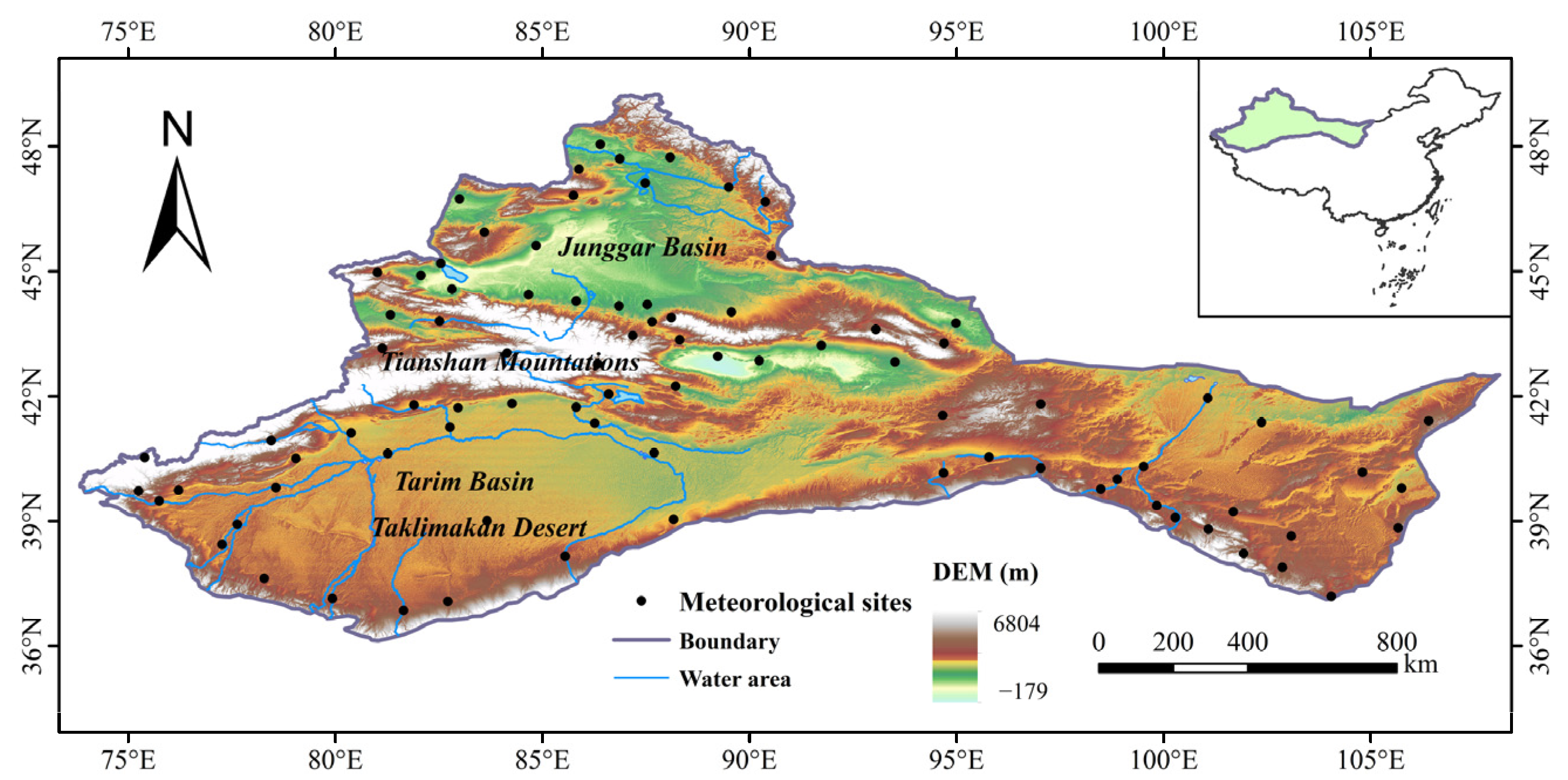
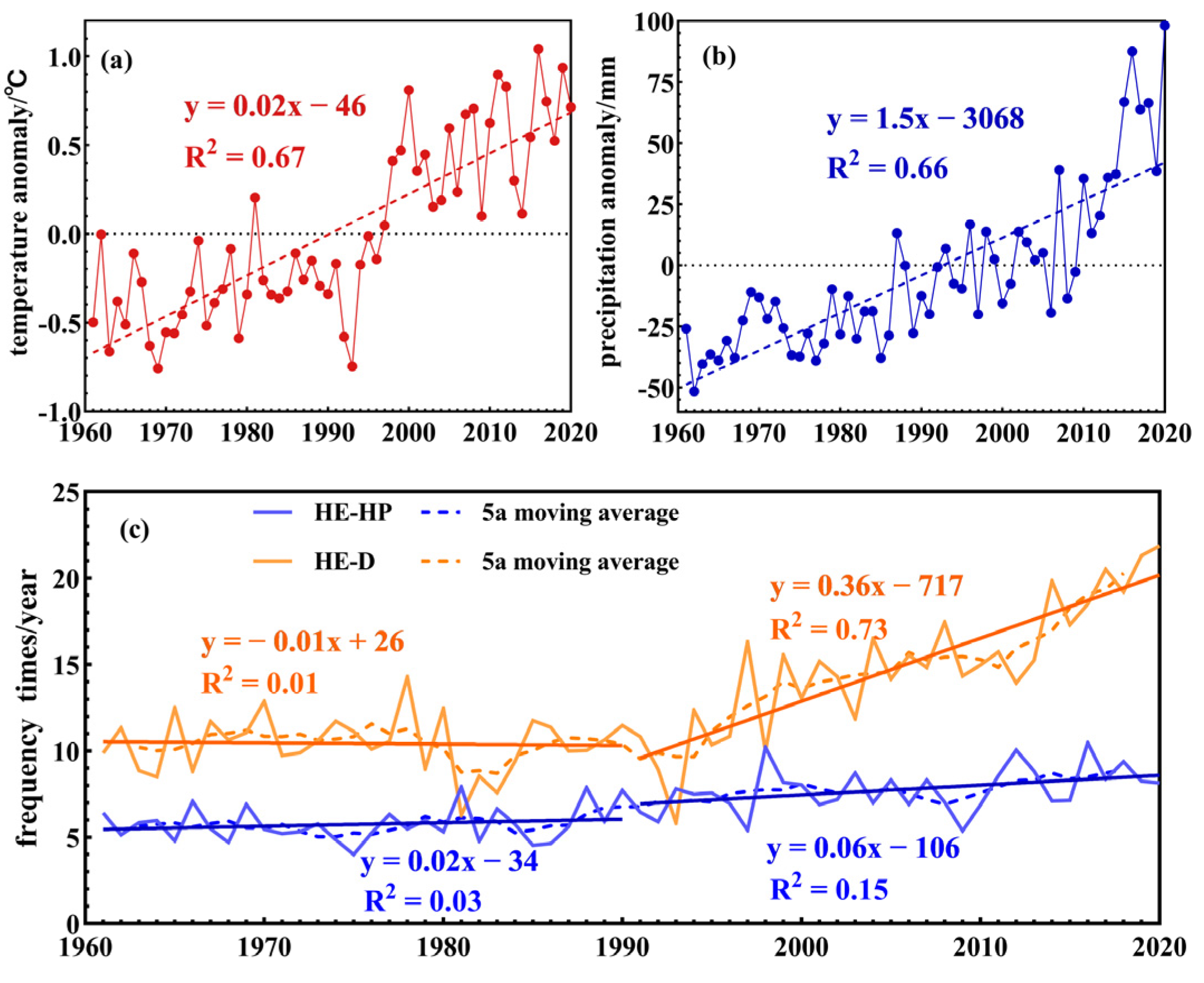


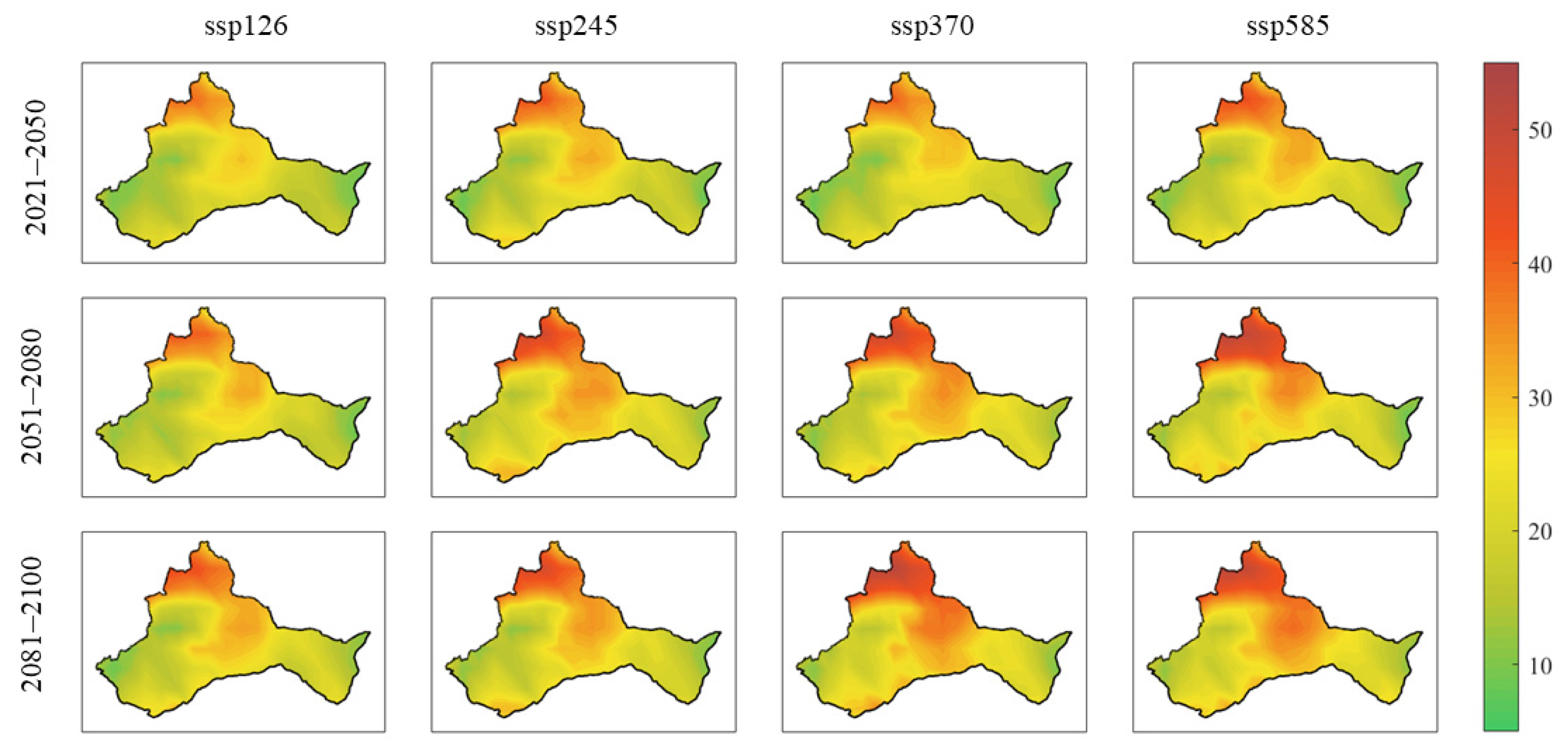
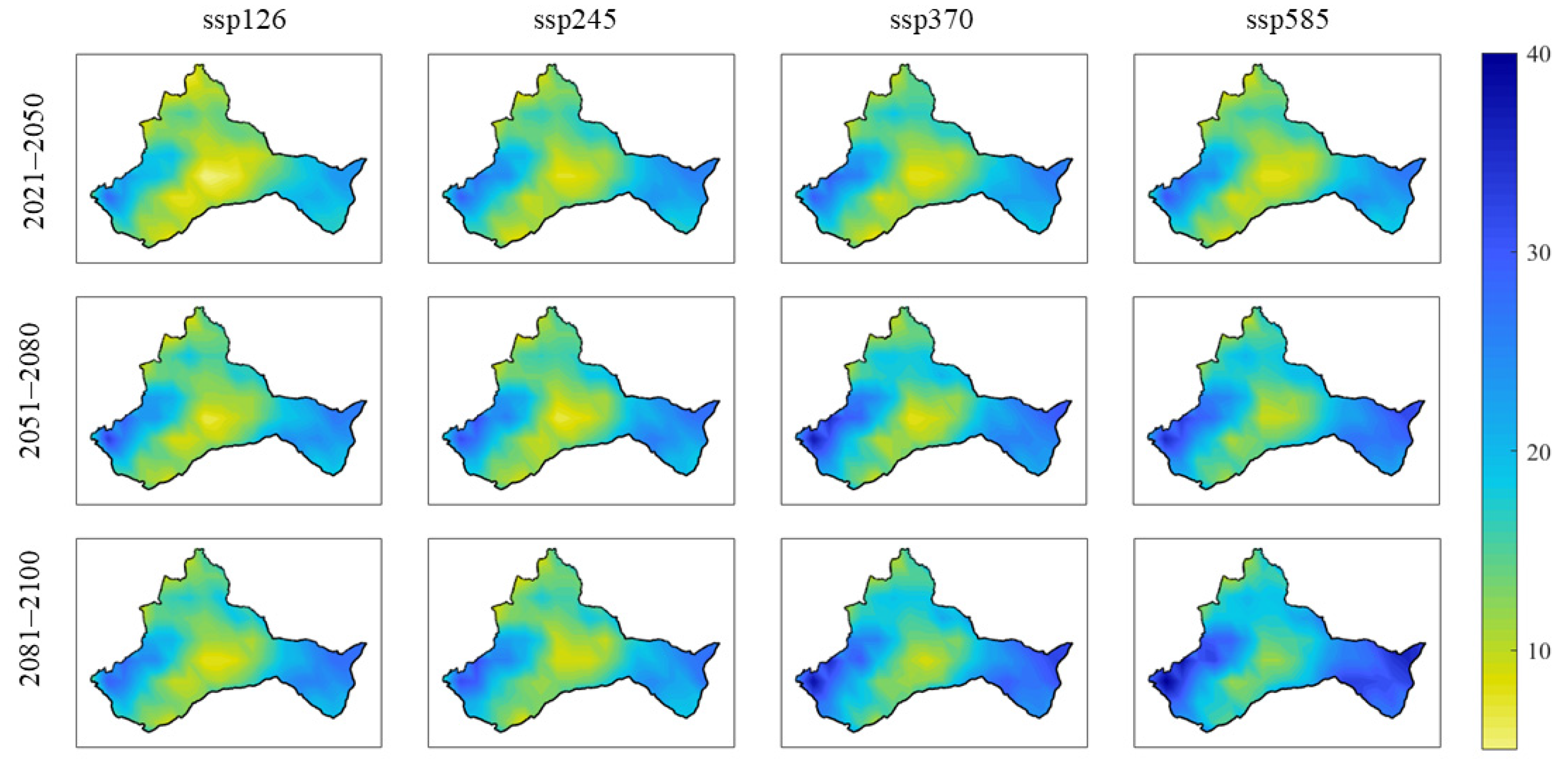
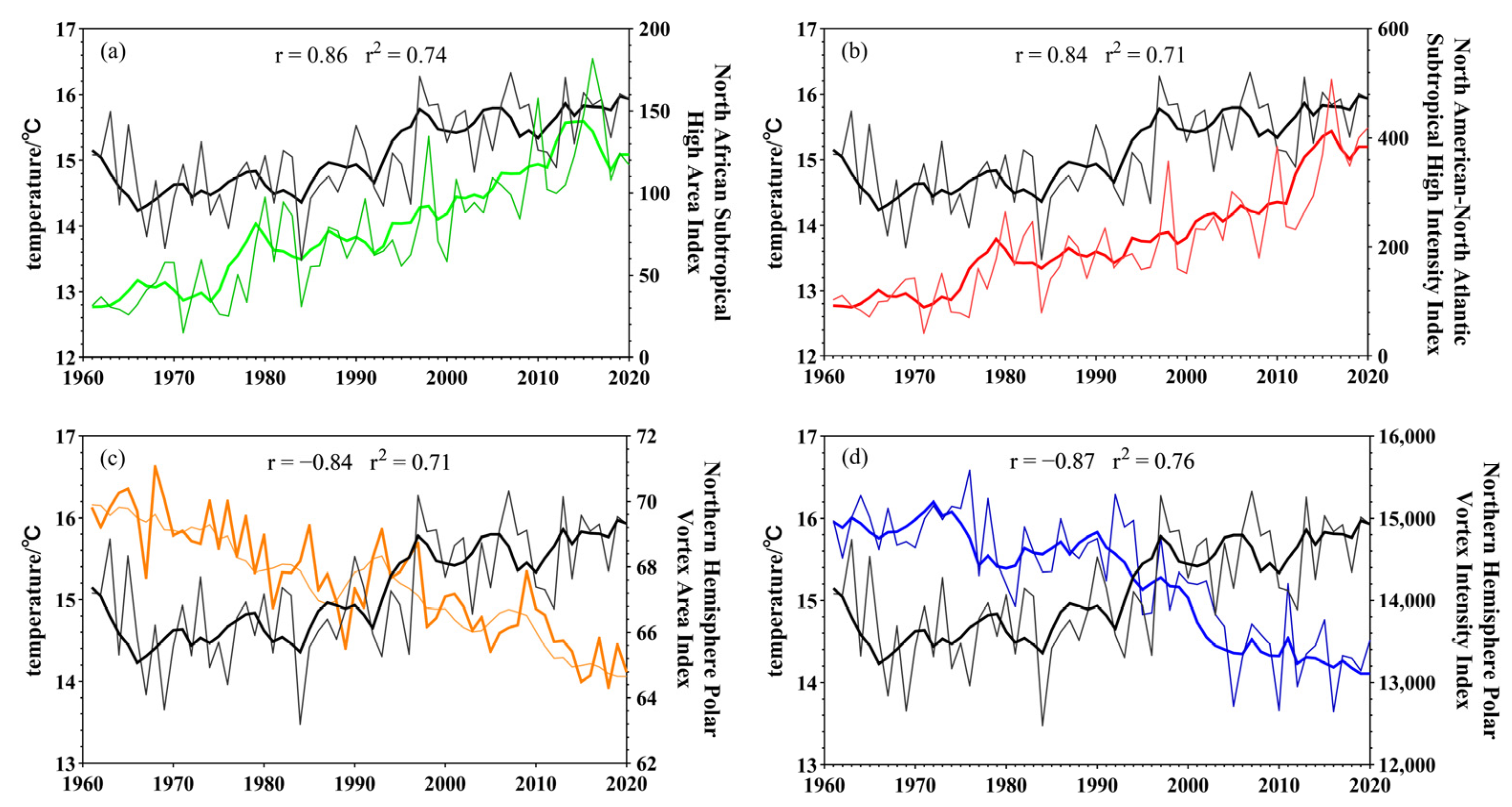
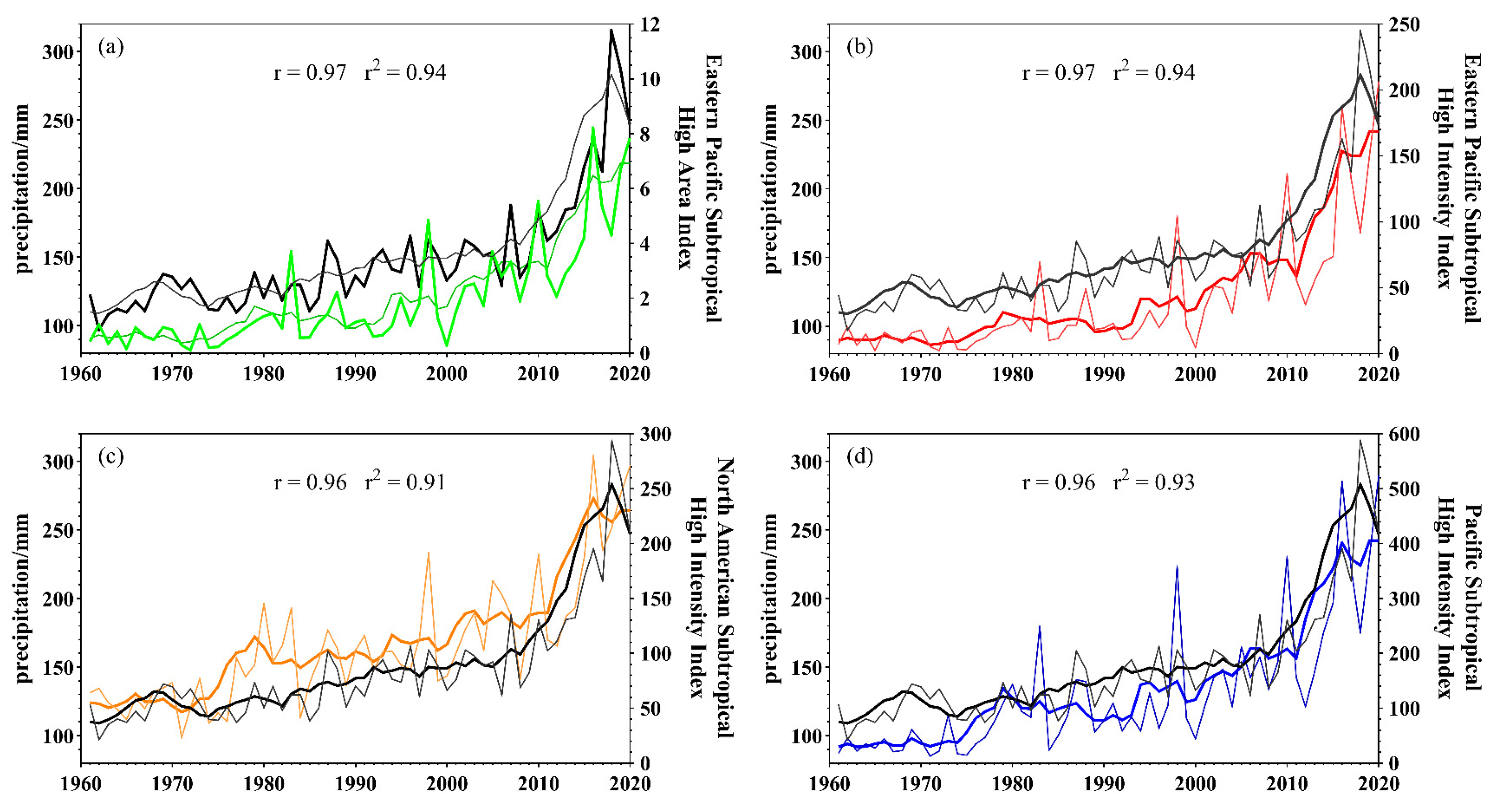
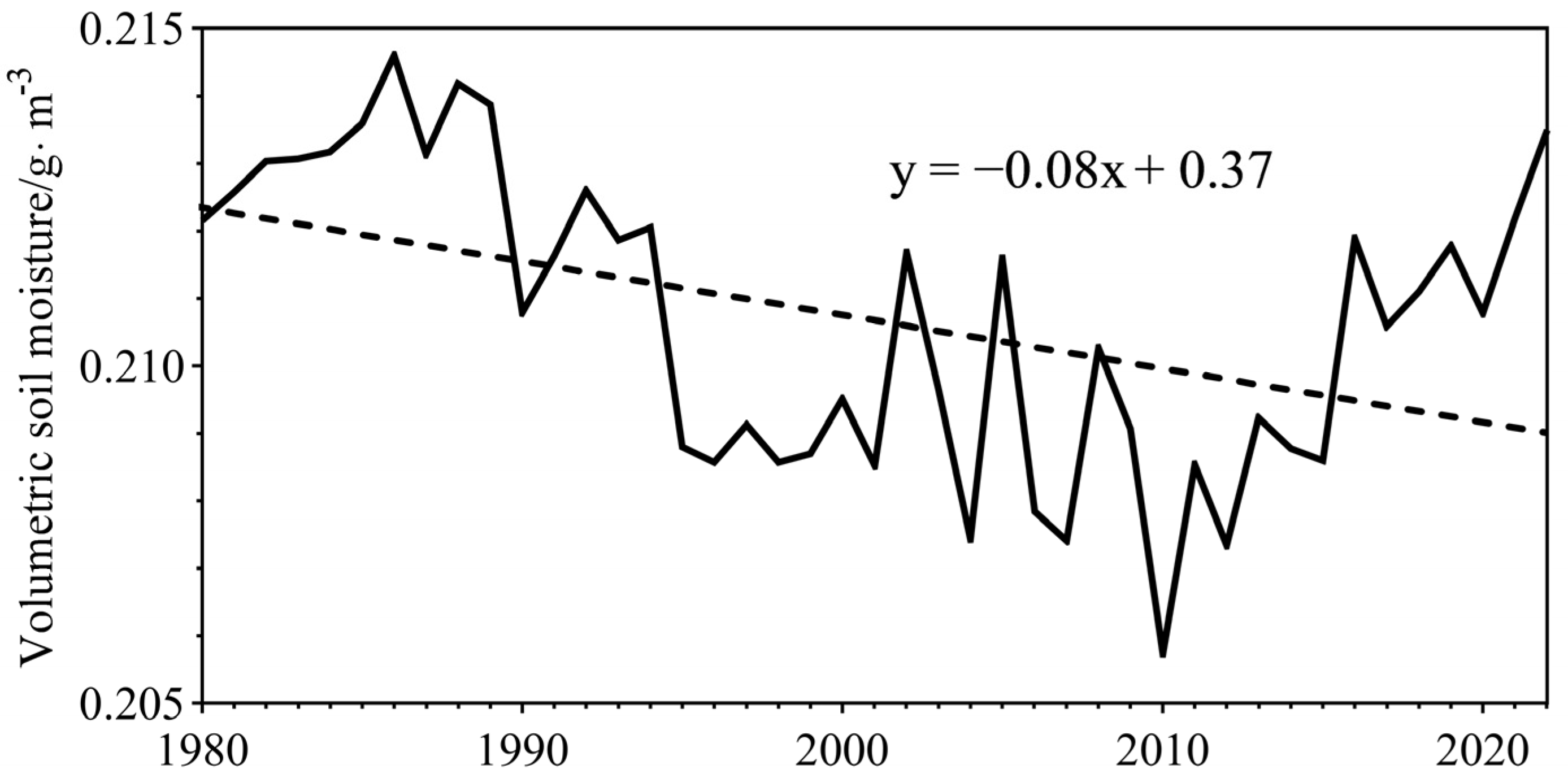
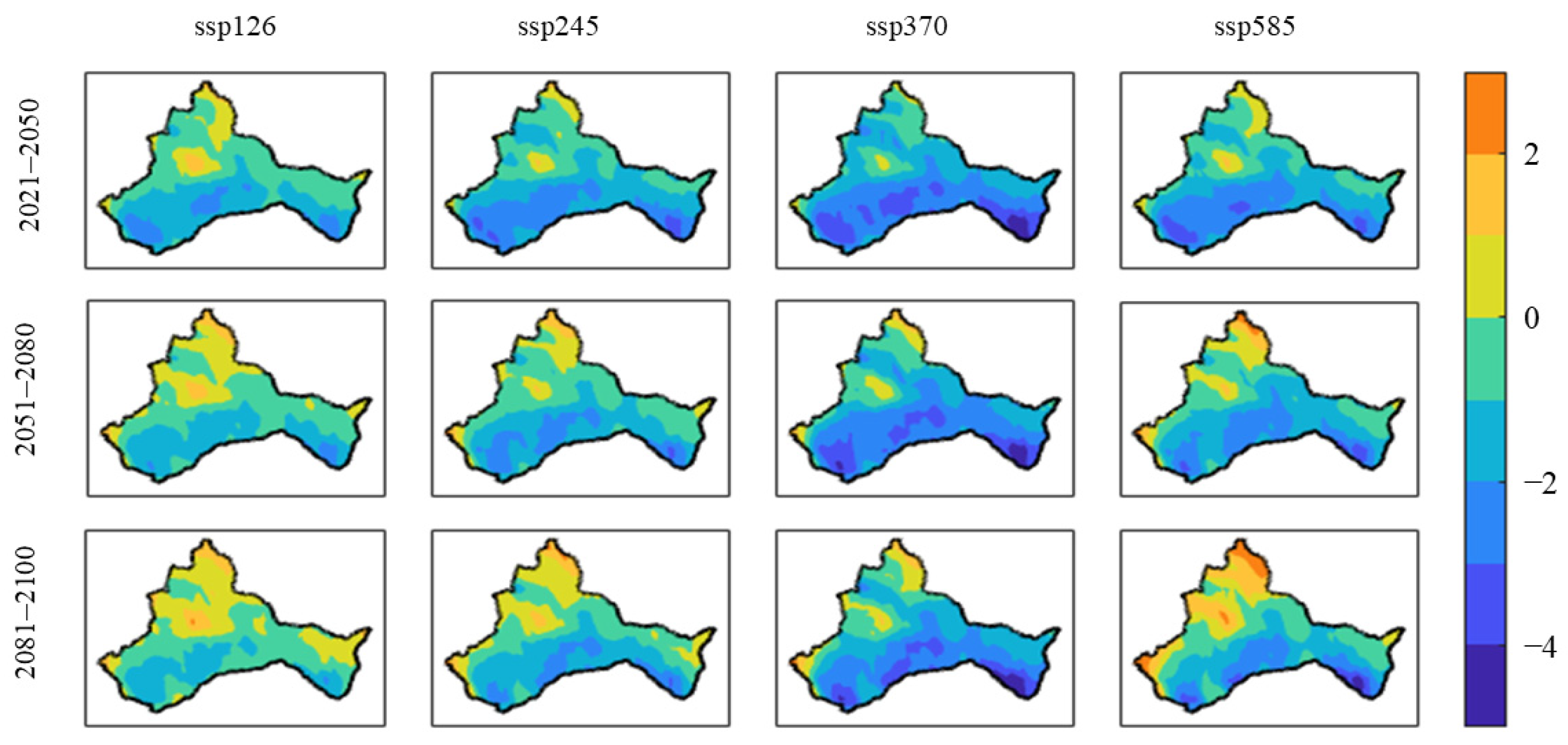
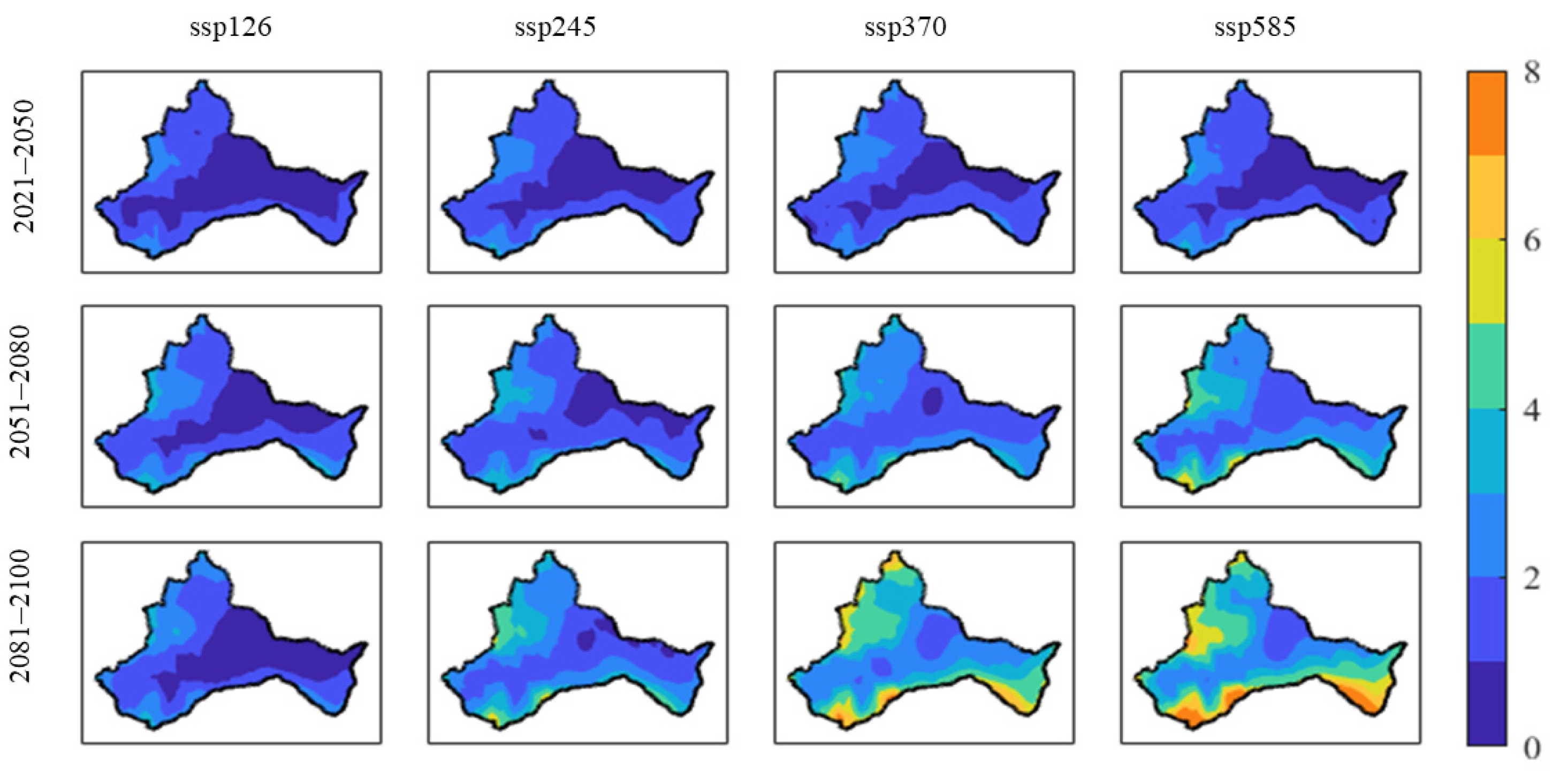

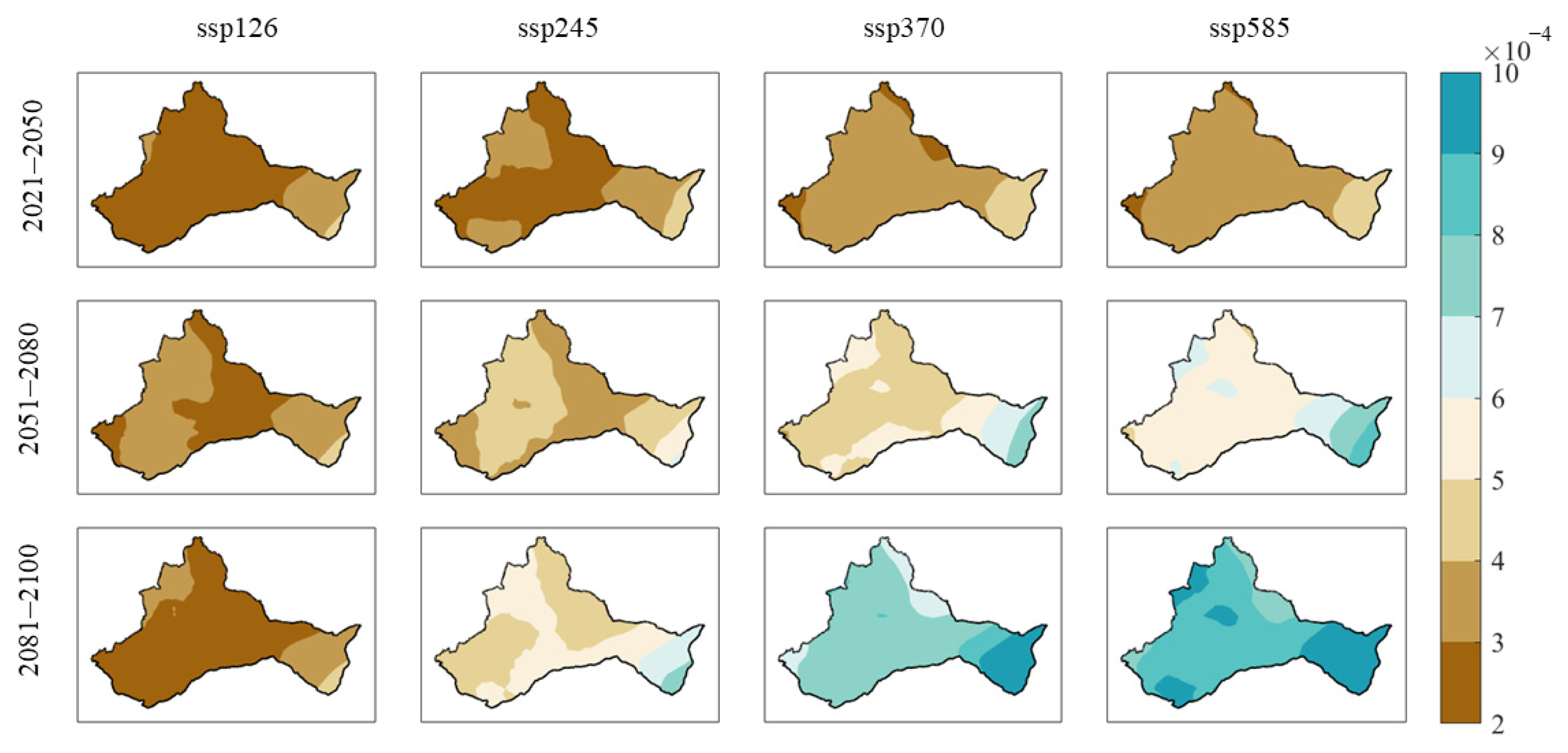
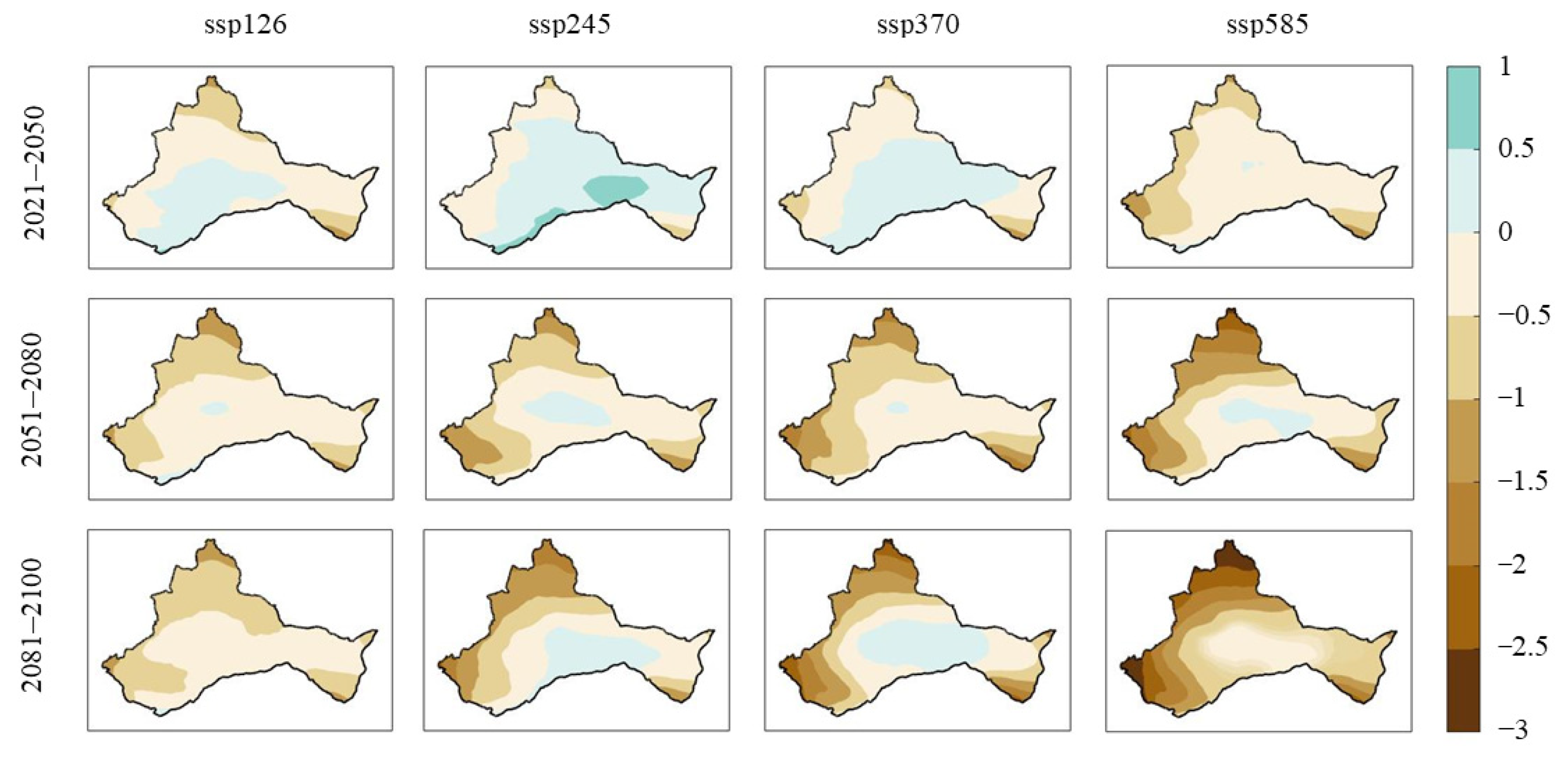
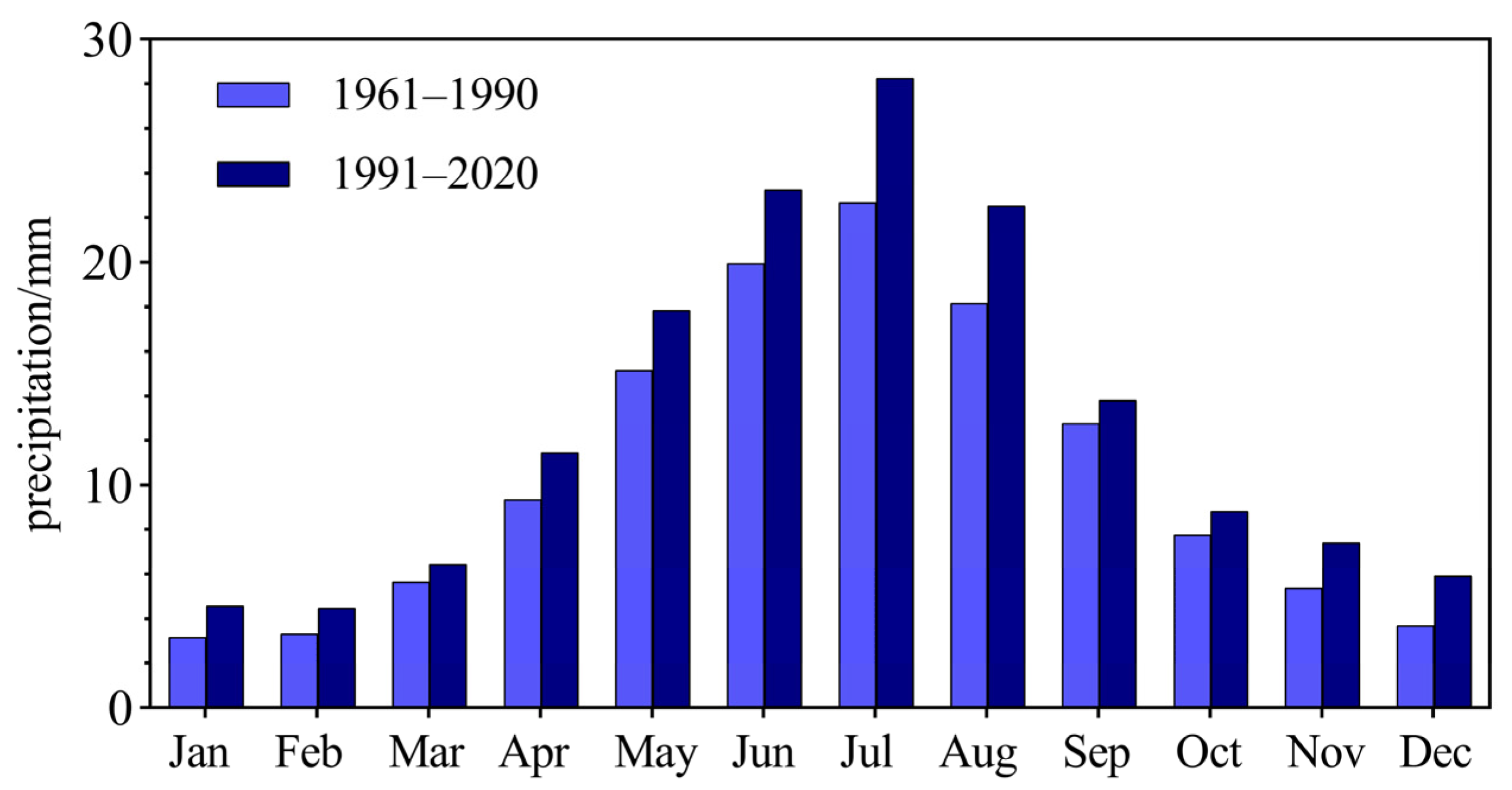

| No. | CMIP6 Model Name | Country | Atmospheric Resolution (Lon × Lat in Deg) | Variant Label |
|---|---|---|---|---|
| 1 | ACCESS-CM2 | Australia | 1.9° × 1.3° | r1i1p1f1 |
| 2 | AWI-CM-1-1-MR | Germany | 0.9° × 0.9° | r1i1p1f1 |
| 3 | BCC-CSM2-MR | China | 1.1° × 1.1° | r1i1p1f1 |
| 4 | CNRM-CM6-1 | France | 1.4° × 1.4° | r1i1p1f2 |
| 5 | CNRM-ESM2-1 | France | 1.4° × 1.4° | r1i1p1f2 |
| 6 | EC-Earth3-Veg-LR | Europe | 1.1° × 1.1° | r1i1p1f1 |
| 7 | GFDL-ESM4 | USA | 1.3° × 1° | r1i1p1f1 |
| 8 | INM-CM4-8 | Russia | 2° × 1.5° | r1i1p1f1 |
| 9 | INM-CM5-0 | Russia | 2° × 1.5° | r1i1p1f1 |
| 10 | MPI-ESM1-2-LR | Germany | 1.9° × 1.9° | r1i1p1f1 |
| 11 | NorESM2-LM | Norway | 2.5° × 1.9° | r1i1p1f1 |
| Atmospheric Circulation Index | R2 | |
|---|---|---|
| Temperature | Precipitation | |
| North Atlantic Subtropical High Intensity Index (NAS) | 0.74 ** | 0.72 ** |
| North American-North Atlantic Subtropical High Intensity Index (NANA) | 0.71 ** | 0.86 ** |
| Northern Hemisphere Polar Vortex Area Index (NHA) | 0.71 ** | 0.74 ** |
| Northern Hemisphere Polar Vortex Intensity Index (NH) | 0.76 ** | 0.68 ** |
| Eastern Pacific Subtropical High Area Index (ESA) | 0.64 ** | 0.94 ** |
| Eastern Pacific Subtropical High Intensity Index (ES) | 0.61 ** | 0.94 ** |
| North American Subtropical High Intensity Index (NAM) | 0.65 ** | 0.91 ** |
| Pacific Subtropical High Intensity Index (PS) | 0.64 ** | 0.93 ** |
Disclaimer/Publisher’s Note: The statements, opinions and data contained in all publications are solely those of the individual author(s) and contributor(s) and not of MDPI and/or the editor(s). MDPI and/or the editor(s) disclaim responsibility for any injury to people or property resulting from any ideas, methods, instructions or products referred to in the content. |
© 2024 by the authors. Licensee MDPI, Basel, Switzerland. This article is an open access article distributed under the terms and conditions of the Creative Commons Attribution (CC BY) license (https://creativecommons.org/licenses/by/4.0/).
Share and Cite
Niu, H.; Sun, W.; Huai, B.; Wang, Y.; Chen, R.; Han, C.; Wang, Y.; Zhou, J.; Wang, L. Causes of Increased Compound Temperature and Precipitation Extreme Events in the Arid Region of Northwest China from 1961 to 2100. Remote Sens. 2024, 16, 3111. https://doi.org/10.3390/rs16173111
Niu H, Sun W, Huai B, Wang Y, Chen R, Han C, Wang Y, Zhou J, Wang L. Causes of Increased Compound Temperature and Precipitation Extreme Events in the Arid Region of Northwest China from 1961 to 2100. Remote Sensing. 2024; 16(17):3111. https://doi.org/10.3390/rs16173111
Chicago/Turabian StyleNiu, Huihui, Weijun Sun, Baojuan Huai, Yuzhe Wang, Rensheng Chen, Chuntan Han, Yingshan Wang, Jiaying Zhou, and Lei Wang. 2024. "Causes of Increased Compound Temperature and Precipitation Extreme Events in the Arid Region of Northwest China from 1961 to 2100" Remote Sensing 16, no. 17: 3111. https://doi.org/10.3390/rs16173111





